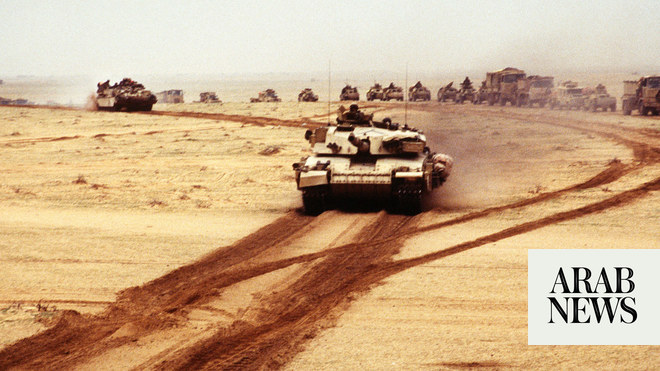
LONDON: The US military has said there is “credible evidence” that British airstrikes against Daesh have killed civilians in Iraq and Syria.
Airwars, an independent civilian casualties group that monitors bombing campaigns in Iraq and Syria, carried out a nine-month investigation into the use of drones and airstrikes by the US-led coalition against Daesh.
Its analysis has unearthed 11 airstrikes directed by European countries from the coalition where at least 40 civilians were killed.
The UK Ministry of Defence (MoD) has said the Royal Air Force (RAF) was involved in three of the strikes listed by Airwars, but no civilians were killed in them.
The RAF has dropped 4,409 bombs and missiles during its five-year campaign against Daesh, claiming that it has killed 3,964 fighters and wounded 298.
Despite this huge amount of firepower, the MoD maintains that it is only responsible for just one civilian casualty.
It has not accepted responsibility for any casualties in Mosul and Raqqa, two cities that have endured heavy bombardment since the start of the violence, with thousands of civilians killed.
In its investigation, Airwars has detailed some 30,000 civilian deaths across Syria and Iraq since violence erupted in 2014.
As of its most recent report, the US-led coalition has claimed responsibility for 1,300 of these deaths, with the vast majority of them due to US Air Force munitions.
The US military included the three RAF strikes flagged up by Airwars as credible events contributing to the civilian death toll.
The group’s director, Chris Woods, said: “The fact that the coalition has determined these three RAF strikes to be credible events is very significant.”
In one incident in January 2017 in Mosul, the MoD said an RAF Tornado jet struck a Daesh bomb truck. It said it was “highly likely” that all those killed in the blast were Islamist militants.
But after an insider tipped off the BBC that civilian casualties were probably involved in the strike, the Pentagon said: “Two civilians were unintentionally killed.”
In Raqqa in August of the same year, the MoD reported an attack on Daesh fighters using mortars.
Airwars said 10 civilians were killed, including a father and his young daughter Walid Awad Al-Qus and Limar Award Al-Qus.
The MoD reported no evidence of civilian casualties at the time, but the US military later said: “Regrettably 12 civilians were unintentionally killed and six were unintentionally injured as a result of the blast.”
Philip Ingram, founder of Grey Hare Media consultants and a former senior British military intelligence officer, told Arab News: “In the targeting process, the greatest emphasis is put on pre-planning and execution to reduce collateral damage in any form.
“Energy is also directed to reduce damage to religious buildings, waterworks and hospitals. It’s very careful.
“In the execution process, the pilot has the ability to turn around. They’ll default to not dropping weapons.
“But in my experience, bomb-damage assessments have been poorly reported by air forces in general.
Ingram added: “The bomb-damage assessment that happens after the execution relies on assets on the ground.
“We have a paucity of assets to find the next threat and also examine what has happened to the last threat. Often there’s not enough available to focus on bomb-damage assessment.”
Ingram said: “An air force won’t necessarily have the assets to detail the radius of the blast and to task people to speak to locals on the ground. That’s not a priority.
“You could waste a lot of assets and lives and not really achieve anything.”
Ingram added that in his own experience in Kosovo, there were many incidents where intelligence officials were told that targets had been successfully hit by a jet while he had “people staring at the target saying there’s nothing there.”
The coalition has been relying heavily on imagery intelligence to understand the extent of damage caused by its attacks in Iraq and Syria.
It is not clear to what extent the US-led force has used ground assets, which give a much clearer picture of the aftermath of an attack, to carry out bomb damage assessments.
The MoD has defended itself by claiming that there is no evidence to indicate civilian casualties in every case where it has been reported or suggested.
But with limited assets tasked to report the outcomes of an attack, it comes as no surprise that the MoD has not been able to confirm incidents of civilian casualties.
A senior US military officer told the BBC that the RAF was “looking for certainty” of allegations of civilian harm, often when there was none.
Following its report, Airwars is calling for a revolutionary change in how the MoD tracks civilian casualties to meet the Pentagon’s standards.
The US, unlike Britain, uses a specialist team for investigating allegations of civilian casualties.
The MoD has not commented on whether it will be looking to bring its standards in line with Washington’s.
Mark Bates, a recently retired active duty RAF pilot, said: “The MoD’s narrative of denial shows how the department is failing.
“Civilians always get caught in the fog of conflict. You can’t have 100 percent guarantee.”
He added: “But rather than engaging the issue and explaining, it chooses another ostrich engagement policy.”












